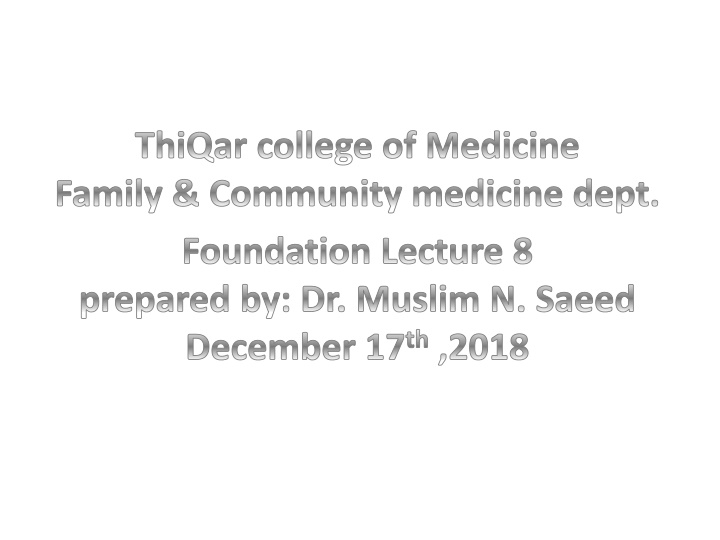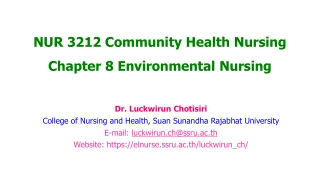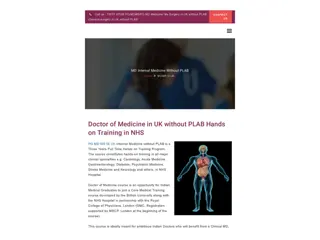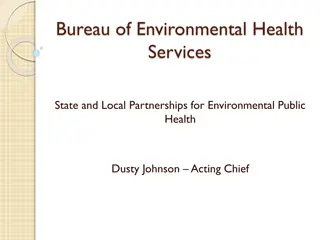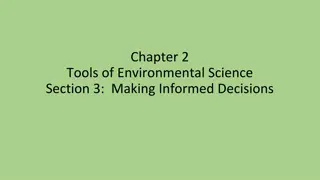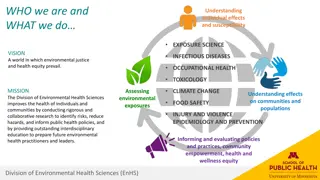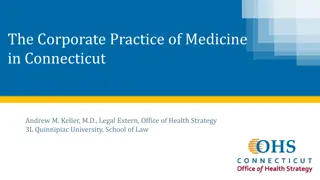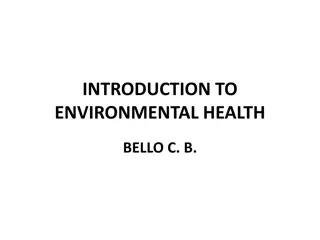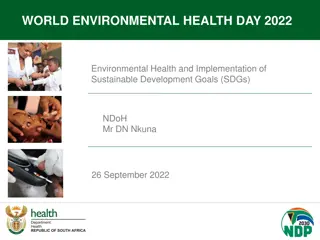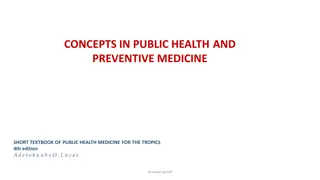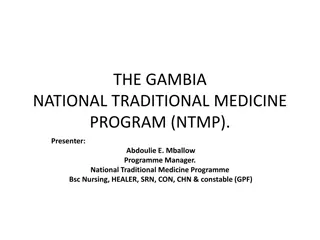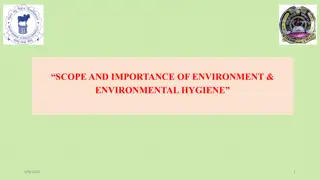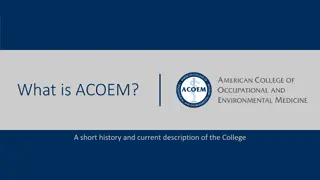Environmental Health in Medicine: Key Concepts and Challenges
Environmental health encompasses the study of how environmental factors impact human health, focusing on areas such as air and water pollution. The lecture highlights the importance of safe water supply and proper waste disposal to prevent disease transmission in communities.
Uploaded on Sep 30, 2024 | 2 Views
Download Presentation

Please find below an Image/Link to download the presentation.
The content on the website is provided AS IS for your information and personal use only. It may not be sold, licensed, or shared on other websites without obtaining consent from the author.If you encounter any issues during the download, it is possible that the publisher has removed the file from their server.
You are allowed to download the files provided on this website for personal or commercial use, subject to the condition that they are used lawfully. All files are the property of their respective owners.
The content on the website is provided AS IS for your information and personal use only. It may not be sold, licensed, or shared on other websites without obtaining consent from the author.
E N D
Presentation Transcript
ThiQar college of Medicine Family & Community medicine dept. Foundation Lecture 8 prepared by: Dr. Muslim N. Saeed December 17th,2018
Environmental health
OBJECTIVES 1) Define the terms health and environmental health 2) List the main areas which represent the focus of environmental health 3) Define air pollution and list the main sources and preventive measures of air pollution 4) Define water pollution, water quality and list the main sources of water pollution 5) Identify the main environmental problems in the governorate.
ENVIRONMENT The total elements, factors, or conditions in the surrounding of man that can affect the human health and well-being. These might be physical (heat, radiation), chemical (pesticides, industrial wastes), biological (viruses, bacteria) or social (smoking, drug abuse).
ENVIRONMENTAL HEALTH All programs that are concerned with the creation and maintenance of good environmental conditions to promote health and prevent disease particularly communicable, malignant and occupational diseases.
THE MAIN INTERESTS OF ENVIRONMENTAL HEALTH 1-Provision of safe domestic water Although safe water supply for domestic purposes is one of the principal requirements for healthy life in the modern world, the water supply in Iraq as a whole is much defected in many aspects. Important defects are the following: 1- The quantity of purified water is inadequate. 2- The quality is defected. 3- Multiplicity of sources of drinking water with all the implications of storage 4- High risk of contamination of drinking water from various sources such as: A - Accidental leakage of sewage into drinking water B - Uncontrolled disposal of sewage and other wastes C- Industrial, agricultural and irrigation drainage D- Spreading of fertilizers E- Insecticides and pesticides F- Dumping of certain wastes at sea G- Spillage of liquids (oil) from ships
2- Safe disposal of wastes of different kinds Major deficiencies are facing the handling of sewage and wastes in Iraq 1- Incomplete coverage by sewage and other wastes disposal 2- Defected system if existed 3- Many areas of the cities are full of garbage and stagnant water 4- Accidental leakage of swage into the pipes of drinking water is very common problem All these are actual and potential sites for the living and breeding of rodents, insects and other unwanted creatures
3- water related and wastes related diseases. Water born and water washed diseases are very common. ex: childhood diarrheas are one of the major health problems in Iraq despite enormous efforts to control such a problem. Cholera, a water born infectious disease, is never absent from the Country over the last years. Inadequate and bacteriologically unsafe water and poor environmental and sanitary conditions are among the main factors associated with occurrence of cholera.
4- Food and milk sanitation Health inspection of imported or locally prepared foods and drinks is very limited. The risk of unsafe foods and drinks is very likely. 5- Monitoring of housing conditions: Safe and healthy Inadequate houses for decent living standards A lot of housing units are insecure. Despite the enormous number of land pieces assigned for private housing, thousands of these land pieces are unused.
6- Control of insects and animal reservoir of infections Despite the great efforts devoted to the control of vector born infectious disease during the past fifty years, many of these diseases are still existing. Some of them may actually be increasing such as visceral leishmaniasis. Currently, very little is being done to deal with insects, rodents and stray dogs.
7-Occupational health Occupation may be associated with certain risks and harmful exposures. Exposure to such undesirable environment may lead to the development of specific occupational diseases, the exacerbation of already existing diseases and a negative effect on productivity of workers and the over all production of a factory or any economic organization.
Safety measures in most industrial enterprises are not adhered to either because of deficient equipment or ignorance by workers of the significance of using protective measures. Also, some occupational health hazards have been reported among workers such as respiratory and allergic diseases.
8- Violence The risk of accidental death is very high in Iraq. Tangible part of this high death rate is attributed to violence according to a recent national household based study published in the Lancet. 9- School environment Although schools are supposed to have high standard environmental conditions in order to safeguard the health of children and to provide them with examples of healthy living, it is exceptional to find a school with optimum environment.
AIR POLLUTION A condition where the atmosphere contains excessive concentrations of foreign matter, which adversely affects health and well-being of the individual and causes damage to property, animals and plants. Sources of air pollution First: Natural sources These result from natural events like volcanoes eruptions, forest burns and storms. Examples are Sulphur dioxide, Nitrogen oxides, Ozone, dust, salts, pollens, biological agents and radioactive matters. Second: Man-made sources, which include: Incomplete combustion of different domestic fuels (liquid, solid or gaseous) Industrial activities such as chemical plants, refineries and phosphate fertilizer plants Community activities and personal habits like smoking Sewage systems Vehicle sources of air pollution: Lead
Effects of air pollution The effect of air pollutants on health depends on: Toxicity of the pollutant (threshold/No threshold) Concentration of pollutant Duration of exposure Individual susceptibility Main effects on health Irritation of respiratory system and Acute episodes of illness and death results occasionally from exposure to severe air pollution associated with unusual weather conditions when a very toxic mixture of smoke and fog is formed. It is called smog. Air pollution may contribute to or aggravate the symptoms and may be a factor in mortality of persons with preexisting chronic respiratory disease, cancer and cardiovascular diseases. Poisoning as in case of CO accumulation in closed space
Prevention of air pollution Environmental modification Personal protection Environmental monitoring Worker education Medical intervention Government regulation (Legislations)
WATER POLLUTION - Safe water is required for: Domestic uses (drinking, hygiene, sanitation, temperature regulation and gardening) Industrial and agricultural purposes - Quality of water is determined by: Turbidity Chemical quality Bacteriological quality Level of chlorination
Water pollution Polluted water is that which is altered in composition or condition so that it becomes less suitable for any or all its natural uses. Sources of water pollution Accidental leakage of sewage into drinking water Uncontrolled disposal of sewage and other wastes Industrial, agricultural and irrigation drainage Spreading of fertilizers Insecticides and pesticides Dumping of certain wastes at sea Spillage of liquids (oil) from ships
Water related infections These are infections, which are related in their transmission to water. They include: Water borne infections such as cholera, typhoid fever, hepatitis A, ascariasis, diarrhoea and dysentery. Infections, which result from water shortage including skin infection (impetigo) and eye infections (bacterial, trachoma) Infections, which are water-based in transmissions (schistosomiasis and Guinea worm) Infections, which need a water-related vector such as malaria.
